
Vintage amateur radio
Encyclopedia
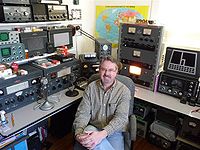
Amateur radio
Amateur radio is the use of designated radio frequency spectrum for purposes of private recreation, non-commercial exchange of messages, wireless experimentation, self-training, and emergency communication...
hobby, considered a form of nostalgia
Nostalgia
The term nostalgia describes a yearning for the past, often in idealized form.The word is a learned formation of a Greek compound, consisting of , meaning "returning home", a Homeric word, and , meaning "pain, ache"...
much like antique car collecting, where enthusiasts collect, restore, preserve, build, and operate amateur radio equipment from bygone years, most notably those using vacuum tube
Vacuum tube
In electronics, a vacuum tube, electron tube , or thermionic valve , reduced to simply "tube" or "valve" in everyday parlance, is a device that relies on the flow of electric current through a vacuum...
technology.
Popular modes of operation include voice communications using amplitude modulation
Amplitude modulation
Amplitude modulation is a technique used in electronic communication, most commonly for transmitting information via a radio carrier wave. AM works by varying the strength of the transmitted signal in relation to the information being sent...
, and Morse code contact using continuous wave
Continuous wave
A continuous wave or continuous waveform is an electromagnetic wave of constant amplitude and frequency; and in mathematical analysis, of infinite duration. Continuous wave is also the name given to an early method of radio transmission, in which a carrier wave is switched on and off...
. Among enthusiasts, there is considerable interest in owning, restoring and operating vintage military and commercial radio equipment, much of it more than 40 years old. Some undertake to construct their own gear, known in ham slang as homebrewing
Amateur radio homebrew
-History:In the early years of amateur radio, long before factory-built gear was easily available, most hams built their own transmitting and receiving equipment, a process that came to be known as "homebrewing." In the 1930s, 40s, and 50s, hams handcrafted reasonable-quality vacuum tube-based...
, using vintage parts and designs. A number of amateur radio clubs and organizations sponsor contests, events, and swap meets that cater to this specialized aspect of the hobby.
Appeal
Many amateurs prefer the relatively precise digital frequency displays and stability of modern, state-of-the-art, microprocessorMicroprocessor
A microprocessor incorporates the functions of a computer's central processing unit on a single integrated circuit, or at most a few integrated circuits. It is a multipurpose, programmable device that accepts digital data as input, processes it according to instructions stored in its memory, and...
based amateur radios. Vintage radio enthusiasts contend that while modern amateur equipment is extremely good at what it is designed to do, it lacks the aesthetic appeal and "soul" of amateur electronic gear from the vacuum tube era. Additionally, many find satisfaction in taking commercially-made amateur equipment from the 1930s-1970s (affectionately called boat anchor
Boat anchor
In amateur radio and computing, boat anchor is a slang term used to describe something obsolete, useless, and cumbersome - so-called because metaphorically its only productive use is to be thrown into the water as a boat mooring.-Hardware:...
s by US amateurs because of their large size and weight) and carefully restoring it back to health.

Very-large-scale integration
Very-large-scale integration is the process of creating integrated circuits by combining thousands of transistors into a single chip. VLSI began in the 1970s when complex semiconductor and communication technologies were being developed. The microprocessor is a VLSI device.The first semiconductor...
replacement, devotees think of boat anchors as "real radio". According to these hobbyists, a hot soldering iron
Soldering iron
A soldering iron is a hand tool most commonly used in soldering. It supplies heat to melt the solder so that it can flow into the joint between two workpieces.A soldering iron is composed of a heated metal tip and an insulated handle...
is almost a requirement for operating a vintage station. Other enthusiasts claim that boat anchors sound better than their silicon descendants, saying that the tube audio from vintage gear is "warmer" and more aesthetically pleasing than the audio produced by the typical modern transceiver. Some hobbyists see vintage radio operation as a valuable asset to help preserve the history and heritage of radio for future generations, and may assist in the restoration and operation of vintage radio equipment for historical exhibits, museums and museum ships.
AM activity
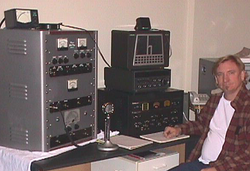
Single-sideband modulation
Single-sideband modulation or Single-sideband suppressed-carrier is a refinement of amplitude modulation that more efficiently uses electrical power and bandwidth....
(SSB). But AM has recently become a nostalgic specialty interest on the shortwave
Shortwave
Shortwave radio refers to the upper MF and all of the HF portion of the radio spectrum, between 1,800–30,000 kHz. Shortwave radio received its name because the wavelengths in this band are shorter than 200 m which marked the original upper limit of the medium frequency band first used...
ham bands. Vintage radio operation has drawn a wide range of amateur radio enthusiasts from rock star Joe Walsh
Joe Walsh
Joseph Fidler "Joe" Walsh is an American musician, songwriter, record producer, and actor. He has been a member of three commercially successful bands, the James Gang, Barnstorm, and the Eagles, and has experienced notable success as a solo artist and prolific session musician, especially with B.B...
, WB6ACU, to former Federal Communications Commission
Federal Communications Commission
The Federal Communications Commission is an independent agency of the United States government, created, Congressional statute , and with the majority of its commissioners appointed by the current President. The FCC works towards six goals in the areas of broadband, competition, the spectrum, the...
attorney Riley Hollingsworth, K4ZDH.
A majority of "AM'ers" stations consist of vintage transmitters and receivers housed in separate cabinets. Some operators have even obtained retired AM broadcast transmitters, donated or sold cheaply to hobbyists by radio stations with no further need for them. Others build their equipment from scratch (called homebrewing
Amateur radio homebrew
-History:In the early years of amateur radio, long before factory-built gear was easily available, most hams built their own transmitting and receiving equipment, a process that came to be known as "homebrewing." In the 1930s, 40s, and 50s, hams handcrafted reasonable-quality vacuum tube-based...
) using combinations of modern and vintage-era parts.
In the United States, shortwave HF
High frequency
High frequency radio frequencies are between 3 and 30 MHz. Also known as the decameter band or decameter wave as the wavelengths range from one to ten decameters . Frequencies immediately below HF are denoted Medium-frequency , and the next higher frequencies are known as Very high frequency...
frequencies (in MHz
Hertz
The hertz is the SI unit of frequency defined as the number of cycles per second of a periodic phenomenon. One of its most common uses is the description of the sine wave, particularly those used in radio and audio applications....
) on which amateur radio AM activity can be found include 1.885, 1.930, 1.985, 3.870-3.885, 7.285, 14.286, 21.425, and 29.010, and sometimes feature "special event" stations using unique call sign
Call sign
In broadcasting and radio communications, a call sign is a unique designation for a transmitting station. In North America they are used as names for broadcasting stations...
s. In the United Kingdom, AM activity can be found almost every day on frequencies between 3.615 and 3.625 MHz.
Conversations (QSO's
Q code
The Q code is a standardized collection of three-letter message encodings, also known as a brevity code, all of which start with the letter "Q", initially developed for commercial radiotelegraph communication, and later adopted by other radio services, especially amateur radio...
in ham slang
Slang
Slang is the use of informal words and expressions that are not considered standard in the speaker's language or dialect but are considered more acceptable when used socially. Slang is often to be found in areas of the lexicon that refer to things considered taboo...
) are typically configured as "roundtables" where several participants take turns developing and presenting their thoughts in a storytelling fashion. Often the conversation revolves around do-it-yourself experimentation, repairs, and restoration of vintage vacuum-tube equipment, which has been rising in value because of nostalgic demand. Interested newcomers are usually encouraged to switch their modern transceiver
Transceiver
A transceiver is a device comprising both a transmitter and a receiver which are combined and share common circuitry or a single housing. When no circuitry is common between transmit and receive functions, the device is a transmitter-receiver. The term originated in the early 1920s...
s to AM mode, introduce themselves, and join the conversation.
Classic gear

Eico
Eico was a manufacturer of electronics kits located in New York City, New York, USA.-History:EICO was established in New York City in 1945 to manufacture electronic test equipment in kit form...
, EF Johnson, National
National Radio Company
The National Radio Company, headquartered in Malden, Massachusetts, USA was an American manufacturer of radio equipment from 1914 to 1991.-History:...
, Heathkit
Heathkit
Heathkits were products of the Heath Company, Benton Harbor, Michigan. Their products included electronic test equipment, high fidelity home audio equipment, television receivers, amateur radio equipment, electronic ignition conversion modules for early model cars with point style ignitions, and...
, Hammarlund
Hammarlund
The Hammarlund Manufacturing Company, founded by Oscar Hammarlund in New York City, New York, USA in 1910, initially designed and produced short wave radio equipment.-History:...
, Drake
R. L. Drake Company
The R. L. Drake Company is a manufacturer of electronic communications equipment located in Franklin, Ohio. It is also known for its line of equipment for amateur radio and shortwave listening, built in the 1950s through the 1980s.-History:...
, Collins, WRL
World Radio Laboratories
World Radio Laboratories, WRL, was a major supplier of amateur radio equipment from the 1950s through the 1970s. WRL was located in Council Bluffs, Iowa, and run by Leo Meyerson and his family....
, Swan
Swan electronics
Swan Electronics was a manufacturer of amateur radio gear located in Oceanside, California, USA.-History:Swan Electronics, then Swan Engineering, began as a one man operation with Herbert G. Johnson, W6QKI, building the first ten single sideband transceivers in a garage in Benson, Arizona during...
, Signal/One
Signal/One
Signal/One was a manufacturer of high performance SSB and CW HF radio communications transceivers initially based in St. Petersburg, Florida, USA. - History :...
, Lafayette
LaFayette Radio
Lafayette Radio Electronics Corporation was a radio manufacturer and retailer based in Syosset, New York. The company sold radio sets, amateur radio equipment, citizen's band radios, and other communications equipment, as well as electronic components and tools through retail outlets as well as...
and Hallicrafters
Hallicrafters
The Hallicrafters Company manufactured, marketed, and sold radio equipment beginning in 1932. The company was based in Chicago, Illinois, USA.-History:William J. Halligan founded his own radio manufacturing company in Chicago in late 1932...
, to make radiotelegraphy (CW), SSB
Single-sideband modulation
Single-sideband modulation or Single-sideband suppressed-carrier is a refinement of amplitude modulation that more efficiently uses electrical power and bandwidth....
, FM
Frequency modulation
In telecommunications and signal processing, frequency modulation conveys information over a carrier wave by varying its instantaneous frequency. This contrasts with amplitude modulation, in which the amplitude of the carrier is varied while its frequency remains constant...
and RTTY two-way contacts. Although 1930s through 1970s gear is considered "vintage", collectors may differ on the cutoff dates.
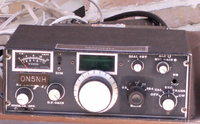
World War II
World War II, or the Second World War , was a global conflict lasting from 1939 to 1945, involving most of the world's nations—including all of the great powers—eventually forming two opposing military alliances: the Allies and the Axis...
, from the ubiquitous US Signal Corps
United States Army Signal Corps
The United States Army Signal Corps develops, tests, provides, and manages communications and information systems support for the command and control of combined arms forces. It was established in 1860, the brainchild of United States Army Major Albert J. Myer, and has had an important role from...
SCR-300
SCR-300
The SCR-300 was a portable radio transceiver used by US Signal Corps in World War II. This backpack-mounted unit was the first two way radio to be nicknamed a "walkie talkie".- History :...
and SCR-536
SCR-536
The SCR-536 was a hand-held radio transceiver used by US Signal Corps in World War II. It is popularly referred to as a walkie talkie although it was originally designated a "handie talkie".- History :...
walkie talkies to exotic gear like the British Paraset
Paraset
The Paraset was a small, low-power, vacuum tube CW radio transmitter-receiver supplied to the resistance groups in France, Belgium and the Netherlands during World War II.- History :...
, a small espionage
Espionage
Espionage or spying involves an individual obtaining information that is considered secret or confidential without the permission of the holder of the information. Espionage is inherently clandestine, lest the legitimate holder of the information change plans or take other countermeasures once it...
transceiver supplied to Resistance forces in France, Belgium and the Netherlands.

Marconi Company
The Marconi Company Ltd. was founded by Guglielmo Marconi in 1897 as The Wireless Telegraph & Signal Company...
, Racal
Racal
Racal Electronics plc was once the third-largest British electronics firm. Listed on the London Stock Exchange and once a constituent of the FTSE 100 Index, Racal was a diversified company, offering products including: as voice and data recorders; point of sale terminals; laboratory instruments;...
, Eddystone, Pye, and a variety of Russian, German, Canadian, British RAF and British Army
British Army
The British Army is the land warfare branch of Her Majesty's Armed Forces in the United Kingdom. It came into being with the unification of the Kingdom of England and Scotland into the Kingdom of Great Britain in 1707. The new British Army incorporated Regiments that had already existed in England...
equipment, such as the well known Wireless Set No. 19
Wireless Set No. 19
The Wireless Set No. 19 was a Second World War mobile radio transceiver designed for the British Army to give armoured troops reliable communications.- Specifications :...
.
Glowbugs
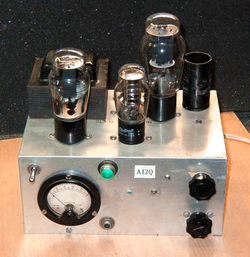
Triode
A triode is an electronic amplification device having three active electrodes. The term most commonly applies to a vacuum tube with three elements: the filament or cathode, the grid, and the plate or anode. The triode vacuum tube was the first electronic amplification device...
Doerle regenerative
Regenerative circuit
The regenerative circuit or "autodyne" allows an electronic signal to be amplified many times by the same vacuum tube or other active component such as a field effect transistor. It consists of an amplifying vacuum tube or transistor with its output connected to its input through a feedback...
receiver and single-tube Hartley
Hartley oscillator
The Hartley oscillator is an electronic oscillator circuit that uses an inductor and a capacitor in parallel to determine the frequency. Invented in 1915 by American engineer Ralph Hartley, the distinguishing feature of the Hartley circuit is that the feedback needed for oscillation is taken from...
, TNT and TPTG transmitters. "Glow" refers to the glow of the vacuum tubes and "bug" to the gear's relatively diminutive size. Generally, any small, home-built tube-type transmitter or receiver may be referred to as a glowbug. The majority of glowbug transmitters are designed to be used in the CW radiotelegraphy mode.
As late as the 1960s, glowbugs were part of many beginner ham stations, and the ARRL Radio Amateur Handbook for those years exhibited a number of such simple, tube-based designs. Today, glowbugs are enjoying a resurgence of interest among QRP
QRP operation
In amateur radio, QRP operation means transmitting at reduced power levels while aiming to maximize one's effective range while doing so. The term QRP derives from the standard Q code used in radio communications, where "QRP" and "QRP?" are used to request, "Reduce power," and ask "Should I reduce...
enthusiasts and others with a penchant for constructing their own equipment. A growing number of hams are "getting back to their roots" by assembling glowbugs on steel chassis, tin cakepans, and wooden boards, and putting them on the air. Amateur radio glowbug enthusiasts can often be heard communicating on the shortwave bands via CW using Morse code
Morse code
Morse code is a method of transmitting textual information as a series of on-off tones, lights, or clicks that can be directly understood by a skilled listener or observer without special equipment...
. A popular frequency to hear glowbug contacts is 3.579.5 MHz, chosen because crystals
Crystal oscillator
A crystal oscillator is an electronic oscillator circuit that uses the mechanical resonance of a vibrating crystal of piezoelectric material to create an electrical signal with a very precise frequency...
for this frequency can be salvaged from discarded color TV sets, along with other transmitter components.
Clubs, events, and publications
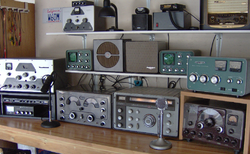
The Amateur Radio Lighthouse Society and The AM Radio Network's "Expedition to Thomas Point Shoal Lighthouse" in Chesapeake Bay, MD honored the heritage of lighthouses. The call sign K3L was issued by the Federal Communications Commission for a vintage special event station that helped commemorate the 100 year anniversary of radio's first voice communications mode, AM.
Britain's Vintage and Military Amateur Radio Society (affiliated with the Radio Society of Great Britain
Radio Society of Great Britain
First founded in 1913 as the London Wireless Club, the Radio Society of Great Britain is the United Kingdom's recognised national society for amateur radio operators. The society's patron is Prince Philip, Duke of Edinburgh and it represents the interests of the UK’s 60,000 licensed radio amateurs...
) coordinates regular on-air "nets" where enthusiasts gather as well as massive technical files for the benefit of members. The Surplus Radio Society, a Dutch
Netherlands
The Netherlands is a constituent country of the Kingdom of the Netherlands, located mainly in North-West Europe and with several islands in the Caribbean. Mainland Netherlands borders the North Sea to the north and west, Belgium to the south, and Germany to the east, and shares maritime borders...
society of collectors of old ex-military radio equipment and other nostalgic receivers and transmitters holds weekly radio activity nets every Sunday on 3.575 MHz CW / 3.705 MHz AM and sponsors several flea markets and exchange fairs each year.
The Canada-based The Wireless Set No. 19 Group, with members virtually world-wide, caters to those who collect, restore and/or operate vintage military communications equipment, with emphasis on the World War II Wireless Set No. 19 radio. Many members are Amateur Radio operators who use the equipment for on-air contacts with others.
The ARRL publishes "Vintage Radio", a collection of articles from QST
QST
QST is a magazine for amateur radio enthusiasts, published by the American Radio Relay League . It is a membership journal that is included in membership with the ARRL. The publisher claims that circulation of QST in the United States is higher than all amateur radio-related publications in the...
magazine describing vintage equipment and restoration, and CQ Amateur Radio
CQ Amateur Radio
CQ Amateur Radio is a magazine for amateur radio enthusiasts. The magazine has a worldwide readership base for its English language edition. A Spanish language edition is published in Spain with some translations of articles from the English language edition and some original European content...
magazine releases a yearly "Classic Radio Calendar" featuring full-color vintage radio images.
Safety
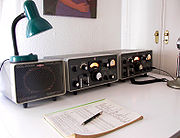
Solid state (electronics)
Solid-state electronics are those circuits or devices built entirely from solid materials and in which the electrons, or other charge carriers, are confined entirely within the solid material...
equipment are cautioned that vacuum tube gear contain potentially lethal voltages. The practice of discharging power-supply capacitors and keeping one hand in your pocket when working on powered-up gear are essential safety measures. Some older equipment directly connects the metal chassis to one side of the incoming AC line, a practice which results in the entire unit becoming electrified if the wall plug is inserted backwards. Many older radios, such as vintage receivers, are not safety-fused. Restorers generally replace the AC line cord with a more modern 3 wire plug and install an in-line or chassis mount fuseholder. The use of a common station ground connection to all equipment is encouraged. Those who collect, restore or otherwise use vintage radio equipment should also be aware of possible radioactive substances.

